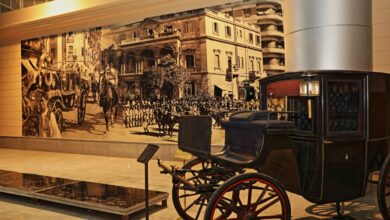For the first time, a contemporary exhibit is being displayed at the Egyptian Museum in Cairo. The exhibit features drawings from the Edfu temple that few people ever get to see. Spanish artists and professors Assunción Jódar Miñarro and Ricardo Marín Viadel created hundreds of pictures, some of which are more than two meters in height, from the western staircase in Edfu.
The exhibition, "Drawings of the time: Impressions from Edfu Temple," is in the museum until 8 April, and is a modern interpretation of ancient artwork. The artists describe their work–pictures drawn of 31 priest figures–as a blend of art and documentation, combing individual creativity with the tradition of sketching ancient sites.
The paintings feature visitors at the Temple of Edfu being welcomed by the three colossal statues of the falcon god Horus at the entrance of the temple, as well as detailed texts of the mythology and rituals that give a clear picture of the arrangement and plan of an Egyptian temple. The use of light and darkness in the temple’s design, while providing a sense of mystique, also obscures the walls in certain places.
"The investigation of art is what truly documents the past," said Miñarro, the director of the department of drawing at the University of Granada. "A novelist of the nineteenth century says more about the nineteenth century than a historian of the nineteenth century. Art is a way of documenting."
The drawings employ colors normally found in pharaonic art, according to the artists, but deviate in a few ways. Since the original colors have disappeared from the walls, they had to guess what would have been there. The original designs are also carved into and painted on walls, not paper, as with the new sketches. The Egyptians also had their own specific methods of creating paint, which are different from modern materials.
The artists were also confronted with the challenge of actually being able to see the walls in the dark. Miñarro and Viadel visited the temple for a week each year from 2006 to 2009, shining lights on the nooks and crannies cut into the faded walls. The ancient artists may also have painted under natural light–if they worked before the roof of the temple was finished–which would have changed the appearance of colors.
"In this stairway it is very dark," said Viadel, who is also a professor of art at the University of Granada. "We need to have special lights on our heads to illuminate the figures and make the drawings. When we made these drawings we used our imaginations."
Each artist gave their individual touches to their drawings. Miñarro’s depictions have soft tones and delicate brush strokes, while Viadel’s have earthy tones and thin lines.
The Cervantes Institute presented the drawings especially to the Egyptian Museum. According to a statement from the Institute, this exhibit follows a trend begun by internationally-known museums, such as the British and Prado Museums, introducing contemporary exhibitions alongside art from the past.
Just as Miñarro describes art as a means of documenting the past, these new drawings could help people in the future understand how humans today view ancient Egypt.
"These drawings are interpretations using the past to return to the present," said Miñarro.
The exhibition is on until 8 April
The Egyptian Museum
Address: Tahrir square, Cairo, Egypt.
Phone number: 025796974, 025754267, 025796948, 02574268
Website: http://www.egyptianmuseum.com/




